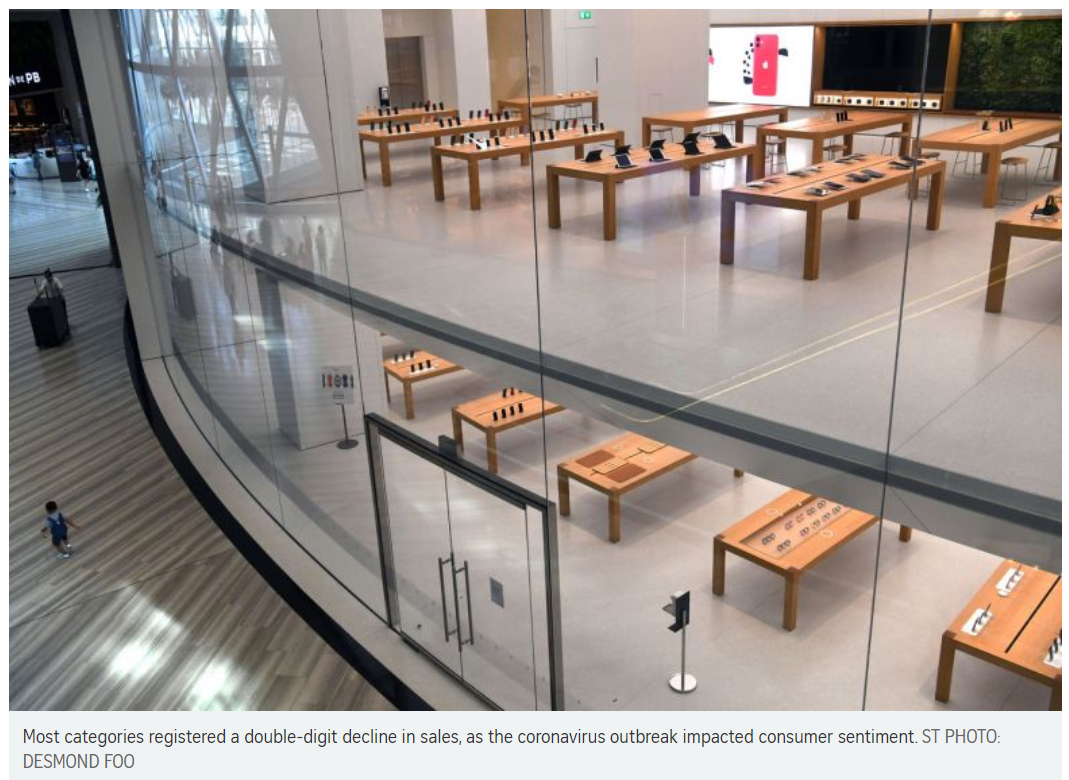Singapore retail sales plunge 13.3% in March, biggest drop in 22 years, on Covid-19 curbs
SINGAPORE – Takings at the till in March sank by the most since 1998 as the coronavirus crisis escalated with safe distancing and stay home curbs, but worse is yet to come with tough circuit breaker measures kicking in only in April, said experts.
Retail sales dropped 13.3 per cent compared with the same period last year, on the back of a decrease in takings from food and beverage services and most consumer categories, according to data out on Tuesday (May 5) by the Singapore Department of Statistics.
This was the worst drop since September 1998 when sales tumbled 16.9 per cent year on year. It also marked the 14th consecutive month of decline, and was sharper than the revised 8.4 per cent fall in February.
Excluding big-ticket motor vehicles, retail sales fell 9.7 per cent in March.
Maybank Kim Eng economist Lee Ju Ye said: “The decline in April and May will likely be far worse due to the circuit breaker measures, and also because consumers are now avoiding expenditure on discretionary items such as watches and jewellery, cosmetics, recreational goods and apparel and footwear, as the economy enters recession and labour market worsens.”
She added that based on Google mobility reports, the movement of people to retail and recreation venues plunged by 70 per cent as of April 26, compared with the first two months of this year.
She noted: “We will likely see the pace of decline for retail sales steepen to beyond -20 per cent in April and May. As a comparison, the steepest declines during the Global Financial Crisis was around -12 per cent.”
Most retail categories registered a double-digit decline in sales, as the coronavirus outbreak impacted consumer sentiment.
Apparel and footwear sales saw the largest drop, at 41.6 per cent, while the sales of food and alcohol also declined, by 41 per cent.
Department stores registered a drop in takings of 38.6 per cent and sellers of watches and jewellery also felt the hit, with sales decreasing 34.4 per cent.
These segments were impacted by the decline in tourist receipts, said the Department of Statistics.
The sales of motor vehicles slid by 28.2 per cent, followed by optical goods and books, which saw sales tumble 23.5 per cent.
Retailers of cosmetics, toiletries and medical goods registered a decline in takings of 21.9 per cent, while recreational goods sales also were down, by 20.6 per cent.
But sales at supermarkets and hypermarkets jumped 35.9 per cent, due to higher demand for groceries as more people stayed at home with safe distancing measures being implemented, the Department of Statistics noted.
Mini-marts and convenience stores also saw takings increase, by 4.7 per cent.
The sales of furniture and household equipment, as well as computer and telecommunications goods, also went up.
OCBC Bank’s head of treasury research and strategy Selena Ling said: “The increase in furniture could be both electrical, such as mini fridges or freezers, and home-work furniture such as work tables and office chairs, for instance. Electronic sales for computers, laptops, monitors and headsets, for instance, (increased) for work from home arrangements, and Nintendo switch for recreational pastime.”
But sales of food and beverage services fell 23.7 per cent, with the decline spread broadly across all industries as a result of lower consumption, with safe distancing measures causing a fall in dine-in takings.
Turnover of food caterers plunged 58.1 per cent, while restaurants saw sales sink 30.3 per cent.
Sales at cafes, food courts and other eating places slid 14.5 per cent, while fast food outlet takings dropped 2.2 per cent.
Online sales continued to rise as consumers stayed home more. The estimated total retail sales value in March came to $3.3 billion. Of this, online retail sales made up an estimated 8.5 per cent, up from 7.4 per cent in February.
The highest share of online sales came from computer and telecommunications equipment, where digital sales made up 41.2 per cent of the total takings for that industry.
Ms Ling added that second-quarter retail sales might contract again by 15.4 per cent before easing to a drop of 4 per cent in the third quarter, as the lifting of the circuit breaker could see a subsequent but muted resumption of economic activities and a tepid demand recovery.
Source: https://www.straitstimes.com/business/economy/singapore-retail-sales-plunge-133-in-march-with-covid-19-curbs-hitting-fb-shops


 English
English




